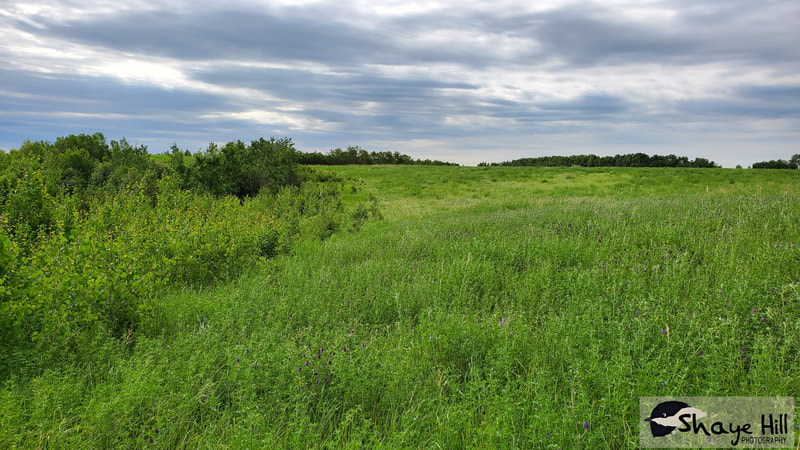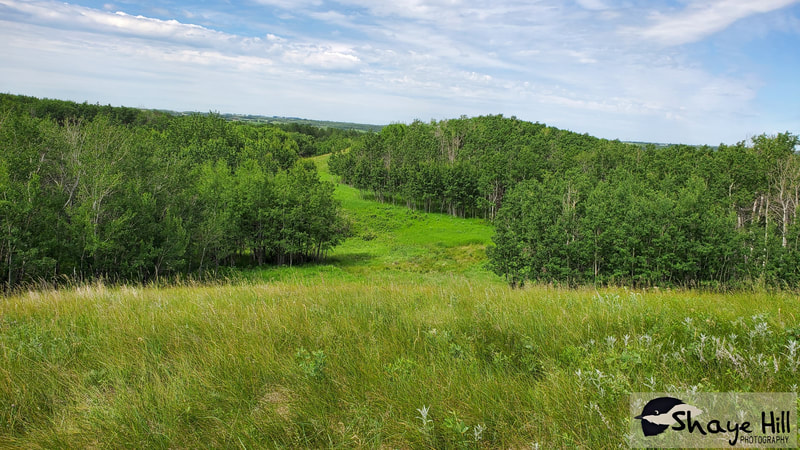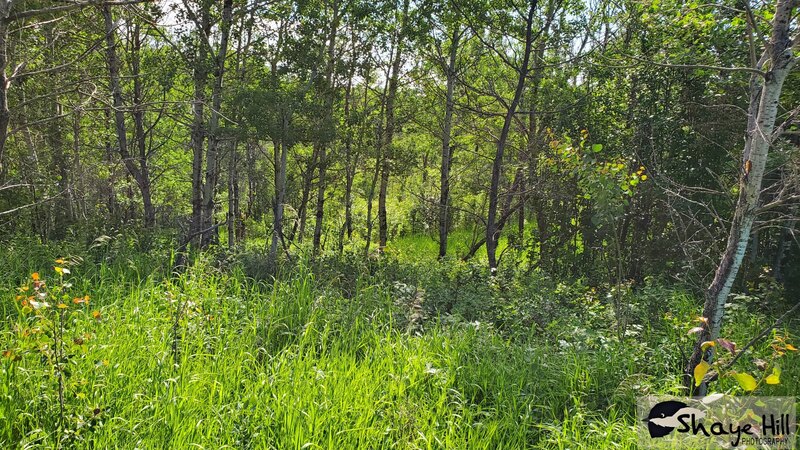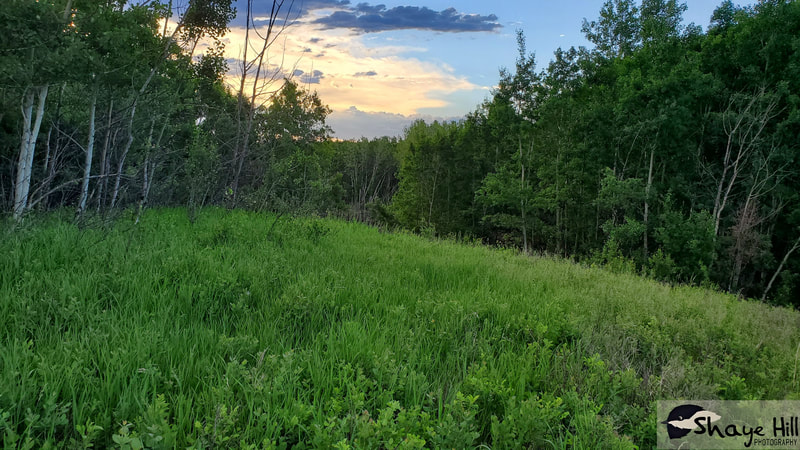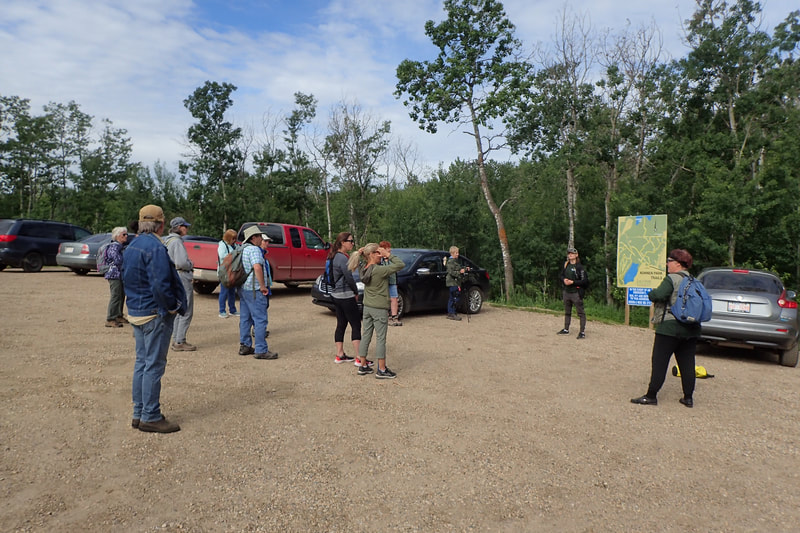|
Underwood June 2021
Underwood - 38.0 km from Red Deer. To reach this area head east on Highway 42 turning south on Range Road 254A right after the yield sign there is a gate with an Nature Conservancy of Canada Sign. Park in the ditch and don't block any gates. The more you explore this area the more you find! Having habitat patches of grassland, wetland and aspen forest. This natural area is rich in plant diversity with some notable flowering species: sticky and Richardson's geraniums, harebell, mountain death camas, wood lily, yellow ladys slipper, and prairie smoke. Many different species of wildlife use this area including white-tailed and mule deer, coyote, red fox, muskrat, beaver, forest birds, wetland birds and grassland birds. There are a few oil lease sites on this property so there are truck paths to walk on. Be mindful this area also leads to the Boote NCC property which needs permission to access (www.connect2nature.ca). Underwood does not need permission to access. The partners than manage this area include Alberta Fish and Game Association and Nature Conservancy of Canada. Happy Exploring! Collins June 2021
Collins - #151 in Alberta Discovery Guide and 44.6 km from Red Deer. This natural area is east on Highway 42 to the north of the road before Highway 21. I park along Range Road 240 being careful not to block any gates. This area is a oasis of wetlands nestled in a grassland habitat. There are a few truck trails but it is easy to walk through if you go off trail. This natural area is on the outskirts of a large wetland, although not part of the natural area you can watch the vast number of waterfowl swim and sit along the shoreline. Last time I was there I saw a Black Crested Cormorant patiently sitting on a fence post airing out their jet black wings. Other wildlife that use this area include white-tailed and mule deer, moose, coyote, red fox and grassland birds. The partner than manages this area is Ducks Unlimited Canada. Be cautious around open water, watch for nesting birds, wildlife in the area and changing weather conditions. Happy exploring! Nova Chemicals Community Walking Trails June 2021
Nova Chemicals Community Walking Trails - 26.4 km from Red Deer. Go east on Highway 11 turning north onto Highway 815. Continue until Township Road 390 turn west and the natural area is to the north. There is a parkinglot that fits around 15-20 vehicles and a bathroom. Along the trail there are some benches and picnic tables. This natural area has 5 km of looped trails to walk through. Boardwalks go overtop of some wetland areas giving a unique look at the surrounding area. Informative signs are scattered along the trails to give more information on the animals and plants that are within the area. There is a little bit of everything within this natural area having aspen stands, grassland patches and wetlands sprinkled throughout. There is a winding stream that flows through part of this area with muskrats, beavers and waterfowl. Many different wildlife species use this area including white-tailed and mule deer, coyote, red fox, forest birds, and grassland birds. The partner that manage this area is Nova Chemicals. Be aware around open water, changing weather conditions, and wildlife in the area. Happy exploring! I really like this area, it's perfect for a small hike and a picnic. Bulka Natural Area
Bulka - #48 in Alberta Discovery Guide and 46.3 km from Red Deer. This natural area is on the east on Highway 590 on the south side of the road, right before the Highway 21 junction. There is a pullout with a sign and a v-gate to walk through. To avoid blocking off any gates park to the side or in the ditch. This natural area is rich in plant diversity. The smell of wild roses is prominent and absolutely refreshing. There are a number of tall hills that give a really good overview of the surrounding landscapes. This area is a nice mix of deciduous forest, shrubland and grasslands. With few but far in-between wetlands. There are some game trails that meander through the forest. The grass is getting very long so thick pants is never a bad call. Wildlife in the area include white-tailed and mule deer, coyotes, moose, forest birds, and wetland birds. The partners that manage is area include Alberta Conservation Association, Ducks Unlimited Canada and Nature Conservancy of Canada. Perfect place to wander and have a picnic surrounded by nature. Baron - #111 in Alberta Discovery Guide and 90.7 km from Red Deer. This natural area is by Buffalo Lake. Heading east on Highway 601 turn North on Range Road 20-0. It is on the east side (right) of the road. No parking lot but there is parking along the ditch look for the green Ducks Unlimited Sign. Do not block any gates.
This area is amazing. Large rolling hills with seemingly endless grasslands with patches of trembling aspen and willow. There are a number of nice wetlands in this area. One is perfect for shorebirds offering up ideal habitat for black-necked stilts and American avocets. Other wildlife in the area include both mule and white-tailed deer, coyotes, richardsons ground squirrels, muskrats, grassland birds, wetland birds, and forest birds. There are a number of wildflowers in bloom the one pictured is a Blanket Flower. There are not very many paths but there are some game trails. It looks like this area is grazed at some point of the year by cattle as per the old cow patties. The partner that manages this area is Ducks Unlimited Canada. Watch for wildlife, cattle, tripping hazards, horseflies, and be cautious around open water. Happy exploring!! Buffalo Lake Moraine Conservation Area - #110 in Alberta Discovery Guide and 97.5 km from Red Deer. This natural area is right off of Highway 56 on the east side of the Highway, north of Stettler. There is a parking lot that can fit about 15-20 cars.
This natural area offers stunning views and a wide diversity of plant an animal life. There are wetlands that can be found throughout the area with some upland shrub habitat surrounded by mature poplar forests. There are balsam poplar trees in this area that are over 100 years old! Wildlife in this area include white-tailed and mule deer, moose, coyote, red fox, forest birds, and wetland birds. There is a pathway in this area called Potter's Seep that is 2 km long that leads to a very unique seepage area. This trail has a number of bird boxes with informative signage indicting the bird species that will most likely use the box. There are numerous other paths made by game animals and some vehicle trails. Partners that manage this area are Alberta Conservation Association, Alberta Fish & Game Association, Ducks Unlimited Canada, Nature Conservancy of Canada, and TD Friends of the Environment Foundation. Be cautious of wildlife in the area, open water, and tripping hazards. As an added note bring bug spray. Happy exploring! This is an amazing area to explore. Stonhouse/Pope - #42 in Alberta Discovery Guide and 26.2 km from Red Deer. Head east on Highway 42, head north up Highway 816. There is a pullout on the east side of the road to access this natural area or you can drive up Highway 816 (north) until Township Road 370 head east and park in the ditch by a gate leading into an oil lease, do not block the gate.
This natural area is giant it is a large chunk of land that goes from Highway 42 to Township Road 370. This area is mostly forested with mature trembling aspen and balsam poplar but there are a few white spruce sprinkled within the forest. There are some grassland patches and wetlands within this area. Wildlife in the area include moose, white-tailed deer, coyote, red squirrels, forest birds and wetland birds. There are very few paths in this area. There is a road that leads to the oil lease but mostly it's following game trails. Still, such an amazing area, I did run into a bull moose while here so be loud and carry bear spray just in case better to have it and not need it. Partners that manage this area are Alberta Conservation Association, Alberta Fish & Game Association, and Ducks Unlimited Canada. Be aware of wildlife in the area, go in a pair or a group, be cautious around open water and changing weather conditions. Be safe and happy exploring!! FYTEN LEA NATURE CONSERVANCY OF CANADA PROPERTY -MYRNA PEARMAN
Although most people are familiar with the broad natural regions found in the province, (mountains, foothills, boreal forest, parklands, grassland, Canadian shield), fewer are aware that these regions are divided into 21 subregions. Alberta Parks has refined the classification system with the goal of preserving, in perpetuity, a network of areas that represents the natural diversity of the province. At increasingly finer scales, landscapes are further classified into categories such as Natural Landscape Type, Natural Landscape Component and Natural Features. This system is well explained in an online document published by Alberta Parks https://www.albertaparks.ca/media/6256258/natural-regions-subregions-of-alberta-a-framework-for-albertas-parks-booklet.pdf Fyten Lea Nature Conservancy of Canada Property The Nature Conservancy of Canada (NCC) is a national non-profit land conservation organization that partners with individuals, governments, corporations, non-profits and Indigenous communities to protect natural landscapes. They secure properties through donation, purchase, conservation agreements etc. and manage them for the long term. Since 1962, NCC and its partners have helped protect 14 million hectares (35 million acres) across Canada. The Fyten Lea NCC property is located in one of the most heavily cultivated regions in Alberta—the Central Parkland Subregion of the Parkland Natural Region. Although home to about 100 (20%) of Alberta’s rare vascular plant species, only about 5% of the Central Albert Subregion remains in native vegetation. Sites like Fyten Lea therefore provide especially important refugia for many native species. Despite its small size (only 53 ha), the property is considered ecologically significant. It is connected to the dramatic Lousana Canyon, an area of about 3,467 ha that straddles the Red Deer River and contains the Tolman Badlands Heritage Rangeland Natural Area as well as portions of Dry Island Buffalo Jump Provincial Park. It is also close to other major tracts of Ducks Unlimited Canada and NCC properties in the area. The property is a rich mosaic of habitats that fall into six broad physiographic zones: a small section on the north side of the highway and five zones on the main property: upper plains above the river valley, open upper valley slopes, forested steep valley slopes, badland slopes, and a bench beneath the slopes. Fyten Lea does have many agronomic and invasive species growing throughout (e.g., smooth brome, Kentucky bluegrass and common plantain) but it supports a rich diversity of native plant communities, including badland cliffs, aspen groves, shrublands (with choke cherry, buckbrush, common wild rose, wild red raspberry, silverberry, Canada buffaloberry), blue grama grasslands, white spruce woods, and classic prairie habitats dominated by thorny buffalo berry, prairie rose, pasture sagewort, scarlet butterflyweed and purple prairie-clover. Although the badland slopes at Fyten Lea are small in comparison to the more geologically and paleontologically significant downstream sites (e.g., Dry Island Buffalo Jump, Horseshoe Canyon and Dinosaur Provincial Park), they are interesting to explore and offer a panoramic view of the Red Deer River Valley (but are treacherous when wet). These slopes are largely bare with scattered patches of long-leaved sagewort, dragonwort, northern wheat grass and creeping juniper. The slopes also support white spruce, ground juniper, silver sagebrush, plains rough fescue, sand grass, June grass, pasture sagewort, northern hedysarum and mountain goldenrod. Fyten Lea also supports some unique features, including saline overflow sites that occur at the base of badland and forested slopes, and a saline draw dominated by plains bluegrass and gumweed. Botanists will appreciate the great variety of grassland and wetland graminoids such as those listed above as well as needle-and-thread, Canada bluegrass, tufted hair grass, graceful sedge and big-head rush, purple oat grass, wire rush, western porcupine grass, needle and thread grass and meadow sedge. Regionally uncommon plants found on the property include yellow lady’s slipper, streamside anemone, heal all, yellow avens and reed grass. Iconic prairie/parkland species such as prairie crocus and shooting stars can be seen in the spring while wild bergamot blankets the hillsides in the late summer. Plant species of concern that have been identified include few-flowered aster and Parry’s sedge, and rare vascular plant species reported within 15 km of the property include few-flowered aster, Canada brome, waterpod, salt-marsh sand spurry, prairie wedge grass and crowfoot violet. Botanists who visit the area are encouraged to share their plant lists with NCC (see contact information below). While we saw only squirrels and a neighbour’s wandering dog on our spring walk, beaver, mule deer, coyote, Canada lynx, white-tailed deer and moose have all been recorded. The area is home to a variety of common birds as well as such notable species as turkey vulture, bald eagle, Say’s phoebes, common yellowthroat and red crossbill. Importantly, the Lousana Canyon is home to provincially listed bird species such as ferruginous hawk, peregrine falcon, prairie falcon and loggerhead shrike. We were pleased to hear two male orange-crowned warblers singing in the aspen forests near the badland cliffs on our May walk. Bird watchers are encouraged to eBird all sightings during their visit. ACCESS: NCC requires permission for access, which can be easily booked through www.connect2nature.ca. Access to south property: east of Elnora on TWP 352, north to the end of RR 214. Parking is in ditch beside fence. Enter though V gate. No clearly marked trails or bathroom facilities. Visitors should be physically fit and have wayfinding skills. Access to the north section is from the ditch along Highway 590. For more information about this property, check https://www.natureconservancy.ca/en/where-we-work/alberta/featured-projects/fyten-lea.html. NCC contact for the property is Hannah Schaepsmeyer Hannah.Schaepsmeyer@natureconservancy.ca Haskell Natural Area - June 14 2021
Haskell - #141 is the Alberta Discovery Guide and 43.4 km from Red Deer. Follow Highway 42 until Highway 21 where you head north until Township Road 370 head North again on Range Road 232 and the area will be on the left-hand side (west) of the road with a green Ducks Unlimited Sign. Park in the ditch and do not block any gates This natural area offers beautiful shrublands, wetlands and mature aspen stands. Wildlife that inhabit this area include mule deer, white-tailed deer, porcupine, coyote, muskrats, forest birds and wetland birds. There are not to many trails that wander though. Existing trails were made by cattle or game animals. Regardless this area is off the beaten trail and is worth exploring! There are numerous species of wildflowers that are in bloom and there are some yellow ladys slipper in the natural area. The partner than manages this area is Ducks Unlimited Canada. Be aware of wildlife in the area, tripping hazards, fences and changing weather conditions. Happy exploring! Kuhnen Park Nature Walk - June 12 2021
First walk of the season at Kuhnen Park was a success and we couldn't be more pleased at the turnout. We are so grateful for everyone's interest in these natural areas and wanting to learn more about them. We saw numerous species of plants and animals. Some notable plant species include a patch of Yellow Lady's Slipper, Glaucous Honeysuckle lining the path, and a small area of Milkweed. Animal species include Police Car Moth Caterpillars, Wood Frogs, Yellow Warblers, Song Sparrows and many others. Hope to see you all at the next one! |




